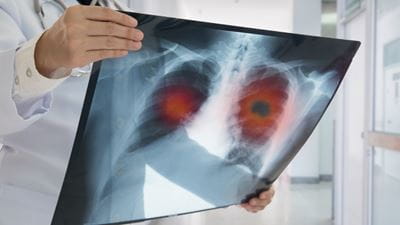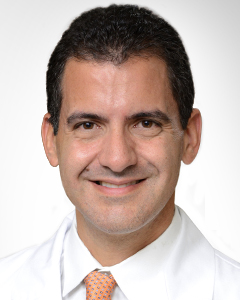Lung cancer is a surprisingly common cancer for both men and women. Other than skin cancer, lung cancer is the second most common form of the disease, with only prostate cancer for men and breast cancer for women diagnosed at higher rates. Lung cancer represents 14 percent of all new cancer diagnoses and is the leading cause of death for both men and women. But newer treatment options, such as robotic surgery, can improve the recovery and outcome from lung cancer surgery.
Who Gets Lung Cancer?
The majority of patients who develop lung cancer are 65 or older, and very few are diagnosed who are under 45. Cigarette smoking is the biggest factor in developing lung cancer, and is linked to 80 percent to 90 percent of lung cancer deaths, but non-smokers can develop lung cancer too. Exposure to second-hand smoke or radon increases the risk of non-smokers developing the disease.
Diagnosing Lung Cancer
Most patients with lung cancer have no symptoms initially.  Only 15 percent may have symptoms, such as a persistent cough, shortness of breath, weight loss or chest discomfort—and those symptoms may be attributed to a less serious illness.
Only 15 percent may have symptoms, such as a persistent cough, shortness of breath, weight loss or chest discomfort—and those symptoms may be attributed to a less serious illness.
There are three main types of lung cancer: non-small cell lung cancer, which is found in about 85 percent of lung cancers; small cell lung cancer, which occurs in 10 to 15 percent of lung cancers; and lung carcinoid tumors, which represent less than 5 percent of lung cancers.
To diagnose lung cancer, a CT or CAT scan is taken and this special x-ray equipment gives a detailed view of the lungs. It is the only approved screening test for lung cancer and is used for patients older than 55 years old, who have high-risk factors such as a history of smoking more than a pack of day for 30 or more years or have been a heavy smoker for more than 15 years. CT scans are preferred over chest x-rays because x-rays don’t provide the quality imaging needed to screen for lung cancer.
Lung Cancer Treatment Options
Once a lung cancer diagnosis is made, the doctor will assess your overall health condition and the disease stage to recommend treatment. If you’re diagnosed at an early stage, the typical treatment is surgery to remove the affected lobe or segment of the lung. This can result in a mild loss of breathing capacity, but most patients can tolerate this and resume normal quality of life without needing to supplement with additional oxygen. Other options to surgery include stereotactic or focused radiation.
Chemotherapy, sometimes combined with surgery and radiation, can be used to treat more advanced stages of the disease.
Robotic Surgery
When surgery is used to remove the affected area of the lung, doctors have several options. Open surgery, or a thoracotomy, requires opening the chest and spreading the ribs to reach the lungs and remove the diseased tissue.
Laparoscopic surgery is a minimally invasive procedure where surgeons make smaller incisions and insert a small camera into the surgical site, so the surgeon can see the area during the procedure.
Robotic surgery, like laparoscopic surgery, is minimally invasive, so the surgeon can perform the operation without opening the chest or spreading the ribs by instead making small incisions between the ribs. But unlike laparoscopic surgery, the surgeon operates from a console, using a robotic system to guide miniaturized instruments and a microscopic camera in the surgical area. This method gives the surgeon greater precision, visualization and range of motion.
Robotic surgery offers a variety of benefits including less pain, lower risk of infection, shorter stay in the hospital and a faster return to regular activities.
Most patients diagnosed with operable lung cancer are eligible for robotic surgery, but success depends on the tumor location and the surgeon’s experience handling more complex cases robotically. At Orlando Health, for example, we offer robotic approaches to more than 90 percent of our lung cancer patients.
In successfully treating lung cancer, early detection is the key. If you have a lung abnormality or lesion, talk with a surgeon early to understand your best method for diagnosis and treatment. While lung cancer is very serious, treatments methods, such as robotic surgery, are constantly improving the chances of recovery and return to wellness.
Are You Interested in Learning More About Robotic Surgery?
Robotic surgeries provide the most advanced technology to treat thoracic cancers. These procedures have fewer surgical risks, allowing patients to spend less time in the hospital after a robotic surgery and experience a faster, less painful recovery.
Learn More










